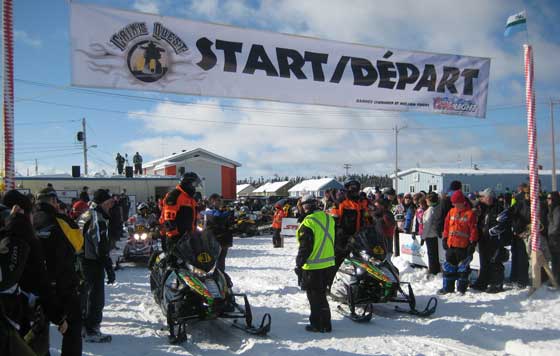
Last month, Tim Lessard and Eric Hall tackled Cain’s Quest for the third time in their careers, finishing second overall in the 1,800-mile endurance race aboard modified 2012 Arctic Cat M800s. Lessard (42), who hails from Monmouth, Maine, was kind enough to answer a few questions about the team’s experience.
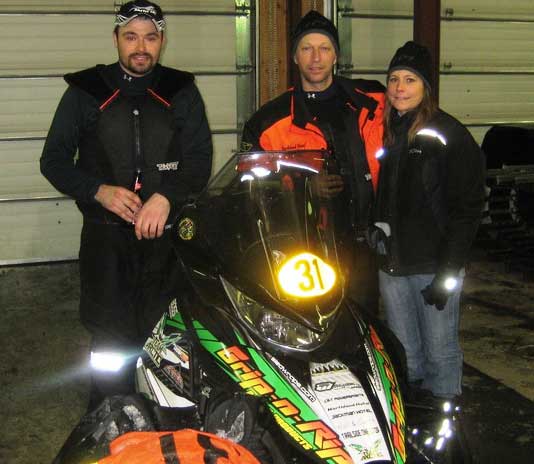
L-to-R: Eric Hall, Tim Lessard, Carey Lessard
AI: Congratulations on the awesome finish in Cain’s Quest! Tell us about your past history with the race, plus your expectations heading into this year’s event.
Lessard: I started following the race the first couple years it ran, helping some of the teams via my company Grip N Rip. I’ve also raced it three times with Eric Hall (of Jackman, Maine), the first time in 2009 on Ski-Doo Renegade 600 E-TEC on which we won. We picked the E-TEC for its good fuel mileage, which is a key factor for success in this race. Everything went right for us that first year, no problems.
There was no race in 2010 because of warm weather.
We raced it a second time in 2011 aboard Ski-Doo 800 Renegades 800 E-TECs, and finished third, about 16 min. behind the winners. That was kind of an unusual race because it was the year racers were forced to carry sleighs in order to bring enough fuel. It was sort of at the last minute requirement, and it changed the strategy and the style of the race by virtue of slowing the pace way down, so everyone kept up. Went into last day two hours behind the leaders but made up almost all of that.
This year was our third time in the race and our expectation going in was that we were racing to win. We took a gamble by racing and all-new model snowmobile. I was always an Arctic Cat guy, and when the ProCross/ProClimb came out, I was excited to return.

AI: Can you give an overview of how this year’s race went for you?
Lessard: We started with M8s with 153-in. tracks because there’s so much deep-snow running. Overall it was a good choice because the sleds really quick in the woods and the tight, slower stuff. The steering effort is really low and easy, and the narrow tunnel is really comfortable to stand, like a dirt bike. We were probably twice as fast as the other teams in the woods and tight trails. But they’d get us on the lakes, in part because we missed getting the right set-up on the rear suspension calibration.
We got better mileage with the M sleds than expected, with the highest around 15-16 mpg. The worst we saw was 9-10 mpg on the last day, when it got warm which resulted in about three feet of slush.
Another pleasant surprise was oil consumption: We were getting around 130 miles per quart, which was better than the 800 E-TEC we raced the year before.
Besides having too soft rear suspension calibration, the other aspect of the race that worked against us was that this year was that there were 4-5 Canadian teams that together pre-ran much of the course, which I think was a big advantage for them.

AI: Describe what makes this race so gnarly.
Lessard: The first third of the race was all deep snow, which was one condition that’s difficult for racing. It was so deep that, with all our extra gear that we have to carry on the sleds, getting through some areas was extremely challenging.
Then, the second section of the race was over a lot of sea ice, which is unique because so rough and hard.
Probably the most difficult of all was area called the Pearly Gates near Nain, a coastal check point. Once you get through the Gates, the terrain was barren tundra, windblown and full of rocks. Some rocks were on the surface and visible, but most were just underneath the snow and we were kind of careening off them. We had fuel for our team dropped in that area, and as we rode towards the drop spot, we realized that no other teams were taking that route. We couldn’t go fast. We had to be super careful because the wrong move would have meant serious problems, which would have mean trying to spend the night in this barren, cold and windy landscape. That section was the first time I’ve ever been scared in three years of competing in the race.
I actually fell off in that section, one ski hit a drift and I tumbled off the sled. Landed on my tailbone and really hurt it.

AI: Is pre-running and familiarity with the course a requirement to win?
Lessard: I don’t think pre-running is a requirement to win, but you have to have the right strategy if you don’t have familiarity with the course. But pre-running sure would help to win.
AI: Why did you switch to Arctic Cat?
Lessard: The biggest reason is that I like Arctic Cat a lot and I’ve always been a Cat guy. Something like 70% of the teams in this race are on Ski-Doo, because it’s a Canadian race. It’s fun to go up against that.

AI: Tell me about the M sleds that you and Eric raced.
Lessard: We focused on making the sleds as comfortable and durable as possible. My biggest concern was the strength of the stock skidframe, which wasn’t designed for the kind of hard packed rough conditions that we race in. We worked really hard with HYGEAR suspension, using their coil-over shocks instead of the stock Float units.
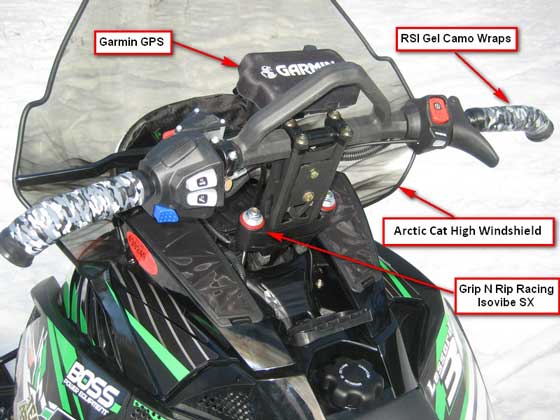
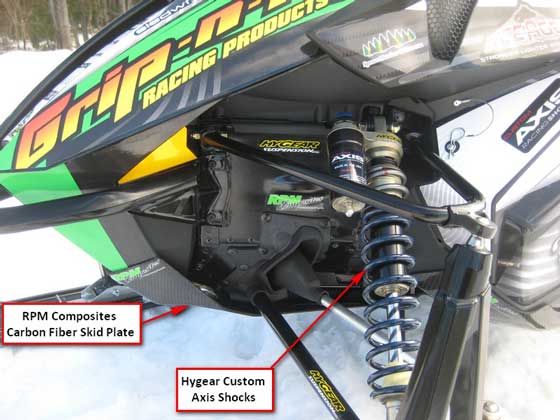
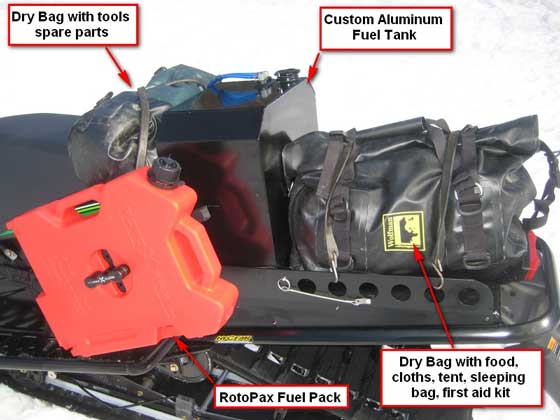
To get the kind of range we needed, we added a custom 10 gallon fuel tank behind seat, pus we added two 2-gallon RotoPax fuel cells on the rear. We had custom rear racks that held our extra gear like spare parts, food, tent, extra clothes, first aid, sleeping bag and such. There was easily 100-150 lbs. of extra weight on the rear end.
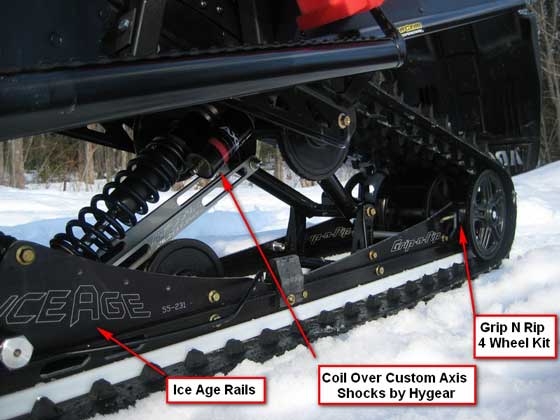
What most affected our race was that we missed the set-up on the rear suspension. We didn’t have enough snow for testing set ups. We had too light of a rear coil-over shock. We had a 225-lb. rear coil-spring, and we probably needed a 300-lb. spring.
We were bottoming out way too easily, in the high speed stuff on the lakes. We barely went over half throttle on the fast sections… maybe going 60-65 mph… while some of the other teams were going 75-80 mph on the lakes. We couldn’t, otherwise would have been breaking.

AI: What did you learn from the race this year?
Lessard: I learned that I might be getting too old for this (laughs). In truth though, it’s one of those races where age doesn’t matter as much, like it would for Iron Dog. You don’t have to have the fastest sled, but it needs to be durable. If you break something, you lose hours and that means you don’t win. The sled also must be comfortable to ride, so you don’t have to stop and rest.
I’d like to do it again. There’s no race next year. If I can get the rear suspension to work better on the M, I’d like to race that again.
AI: Tell me about your company, Grip N Rip.
Lessard: It’s a small home-based company. We’ve been around for 12 years. We started with IsoVibe riser system and kept building slowly by focusing on products that add strength and durability to machines. I design the stuff and my wife runs the company. Our goal is to grow the company so that it can support more employees.
Part of the reason we compete in Cain’s Quest is to develop, test and promote our products.
AI: You used to work at Arctic Cat.
Lessard: In the late 1990s I worked for 2.5 years in Engine Group in Engineering, under Donn Eide. It was probably the best job I’ve ever had. I loved getting up and going to work every day. I have many great memories of being there, as well as living in Thief River Falls. The people were the best. Both my wife and I are from Maine, and we missed it. When our daughter was born, we decided to move back home to be closer to our families.
AI: Do you have a good Roger Skime story?
Lessard: One spring the engine group was in Thompson, Manitoba, testing 440 fan-cooled engines. We were testing our 440 against the Polaris. I spent 2-3 hours with Roger doing side-by-side testing, comparing to the Polaris. We were testing on hardpack, in loose snow. It was non-stop testing. At the end of that day he gave me complement: saying that it takes a special person to see the details in how a snowmobile works. That compliment felt great. It was cool that Roger was there in the first place, taking notes and being involved, because most VPs don’t actually work in the field.
I remember another time, working on the prototype 500 and 600 twin-cylinder engines. We were in a meeting at the plant, with all sorts of people. Roger got quiet, looked around the table and then expressed to everyone how important these engines would be to Arctic Cat. It was so apparent how important the company was to him, that the success of the machines meant everything in the world to him. He’s such an inspiring person.


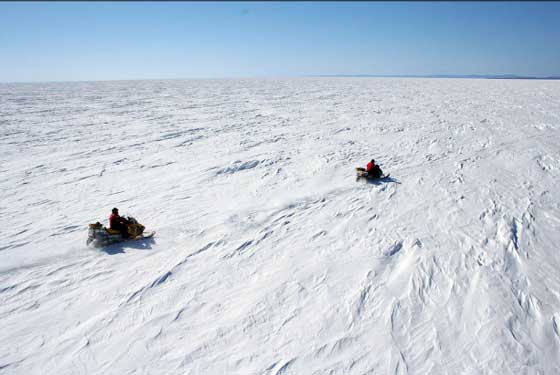
I got to spend some time with Tim and Eric racing Cain’s Quest. They are both great guys and super racers with a Cain’s Quest record to prove it.
I remember Tim! He was a great guy and fun to work with. The only time I ever seen him flustered will forever be knows as “The Mustard Incident”
Great article, John! I had been looking forward to it ever since you mentioned you had one in the works. I started following Cain’s Quest a few years ago when my second cousin, Rob Hallstrom, decided to enter. Now I am a dedicated fan. Keeping up with Cain’s Quest on their website, their Facebook page, and the tracking feature for the racers is more fun than watching the Super Bowl.
Tim’s company, Grip N Rip, has some great products that I would like to try on my machine. While I am not into racing (getting too old for that), I do like long distance boondocking. Reading the article on Team 31 in the Spring 2012 issue of SnowTech magazine, checking the Grip N Rip website and their Facebook page, and now this article has given me many ideas. I have sent many messages to Grip N Rip with questions about their race machines and they have been quick to respond with helpful answers. I look forward to doing business with them.
Since it looks like there will be no Cain’s Quest next year but will be held again in 2014, I may go through withdrawal symptoms. Might have to work on my kitty installing Grip N Rip products for relief.
Thanks for the story John… great to hear all the details. I have know Tim for years and his products work great!
This is a great article…In last 3 years I have been in the race (cainsquest) with Tim Lessard and Eric Hall both guys are good competitors.
What type of gps mount was used ? Any model #? Looks good for running with gauntlets. Anything Cains tested has to be good.